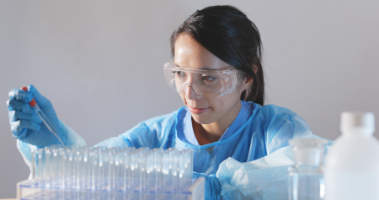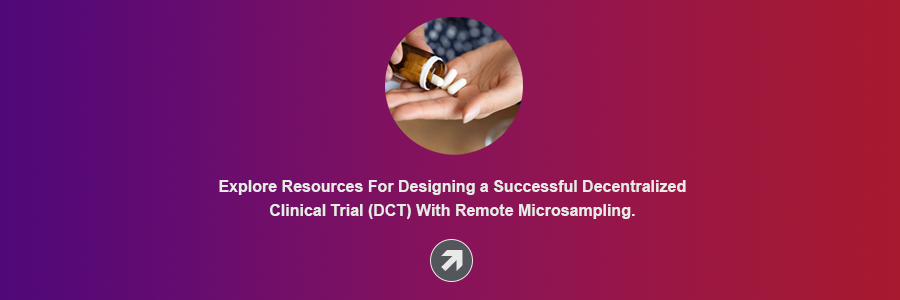Share this
2 solutions overcome the 6 top objections to clinical trials
by Neoteryx Microsampling on Mar 22, 2021 9:00:00 AM
 Organizing a clinical trial is no easy feat. Researchers must recruit a group of willing participants. The participants must meet the study criteria and be prepared to comply with all of its processes and requirements (including regular specimen collection for lab testing, filling out paperwork, etc.). Participants must be committed to participating through completion of a trial.
Organizing a clinical trial is no easy feat. Researchers must recruit a group of willing participants. The participants must meet the study criteria and be prepared to comply with all of its processes and requirements (including regular specimen collection for lab testing, filling out paperwork, etc.). Participants must be committed to participating through completion of a trial.
It is no surprise that trial managers often have trouble finding enough qualified participants to run robust and medically useful studies and drug trials. This is especially true when volunteers with rare conditions are needed.
Common Barriers to Clinical Trials Solved with Remote Technologies
Study volunteers cite a number of barriers to participating in clinical trials and/or reasons for abandoning them midway. Many of the same barriers or objections are raised by a majority of potential recruits and trial participants, regardless of their demographics.
A trial design that combines the use of telehealth communications (email, telephone calls, video conferencing, and more) and remote specimen collection tools, such as Mitra® devices with VAMS® technology, can help overcome many of these barriers and make clinical study participation much more attractive to prospective volunteers. Here we take a look at the most common barriers of clinical trials.
6 Top Barriers to Patient Participation in Clinical Trials
1. Inconvenience
Participating in a clinical trial is not often a short-term commitment. People enrolled in a trial are expected to visit trial sites multiple times over the course of several months, or sometimes over several years. These visits can significantly disrupt participants’ lives, including travel time and the cost of travel to and from the site, which can add up over time.
2. Lost Productivity
The site visits that clinical trials require often occur during conventional business hours, and this means that many participants are forced to take time off work or school to attend. They may lose wages or miss important lessons or exams, which can impact their work performance or grades. This is a significant deterrent for many prospective participants, especially for people who are already facing financial difficulties.
3. Time Burdens
Site visits for clinical studies are rarely brief. Each visit can easily take hours of a participant’s day between the time it takes to travel to the facility, wait to be seen, get the necessary specimens collected, wait for the lab results, speak to the various professionals involved, and finally exit the facility and travel back home. It can be difficult to convince participants that it is worth their while to spend so many hours on a clinical trial, even if they are receiving a small remuneration and/or are eager to play a part in advancing medical science.
4. Paperwork
Clinical studies are, by definition, just one phase in an academic research process. They frequently involve mountains of paperwork. Study participants are asked to complete intake papers, consent forms, and to document progress and side effects. They are also often asked to keep behavioral journals. Filling out this paperwork can take a lot of time and can be frustrating if participants are not adept at reading, writing, reporting and documenting.
5. Specimen Collection
Many clinical studies require participants to undergo regular specimen collection for lab testing to see how the drug or treatment on trial affects their body chemistry. It is very common for participants to become anxious at the prospect of undergoing regular specimen collection events that involve jabs with needles. For example, if blood draws are required, their stress and anxiety may be due to needle phobia or the sensations they experience following high-volume blood draws. This anxiety can be severe enough to deter people from participating in drug trials altogether.
6. Side Effects
It is impossible to know what side effects each individual participant will experience during a clinical trial. That’s the point of conducting the human trial phase of the research. This uncertainty frightens many people and causes them to refuse to participate. While some participants will receive benefit from a drug or vaccine on trial, with no noticeable side effects, others may be negatively impacted.
Staffing and Budgetary Considerations
Most of the challenges that trial participants face also impact researchers and the companies that employ them, albeit in different ways. Scheduling appointments, conducting in-person visits with patients, collecting samples onsite, and sorting through hundreds of pages of paperwork can take up valuable time and resources that could be put to better use. What's more, allocating space and staff to perform all this work is very costly. It’s important to consider new ways to conduct clinical studies that avoid these challenges and reduce costs.
Overcome the Barriers with Remote Microsampling and Telehealth Solutions
With remote specimen collection and telehealth communications technologies, clinical trials don't need to be conducted onsite at a facility using conventional processes. Instead, they can be done almost entirely remotely, offering a potential solution to most of the barriers cited by clinical trial volunteers and staff.
Using remote methods to decentralize a clinical trial is:
1. Convenient
Telehealth technology allows communication between researchers and participants anywhere, even on the go. Similarly, remote microsampling frees participants from the need to visit a trial site on a regular basis. A remote approach gives participants the ability to collect samples at home or wherever they are, within the time points required by the trial coordinators. They no longer need to worry about scheduling trial appointments around other commitments, which means they won't have to miss work or school to participate. This makes them more likely to sign up for a trial.
2. Fast
New technologies can greatly speed up many of the steps involved in conducting clinical trials. Online portals can accelerate the paperwork process and reduce the strain of those duties for participants and staff alike. Remote specimen collection tools with easy-to-use technology can cut the sample collection process down to just a few minutes. Participants easily figure out how to use their sample devices by using the enclosed instructions or watching simple how-to videos online.
3. Minimally Invasive
Microsampling is minimally invasive. Collecting a "microsample" requires only a small finger-prick to the fingertip to draw a small drop of blood. This is far less uncomfortable than having several vials of blood extracted using conventional phlebotomy methods that involve puncturing a vein in the arm. Even participants with blood-test anxiety tend to react well to performing their own finger-prick sample collection in the comfort of home.
4. Safer
Microsampling extracts tiny samples, which places very little stress on the patient’s body, especially as compared to collection methods that require several vials of fluid. This makes it a less risky option for more fragile patients, such as children, the elderly, and those with certain medical conditions. Collecting samples this way is also less likely to cause unpleasant sensations like lightheadedness or weakness that sometimes occurs with standard blood draws. Additionally, self-collecting specimen samples at home for mailing back to the lab keeps people out of facilities where they might risk exposure to contagions, such as the novel coronavirus. People have become more aware of this safety concern in light of the highly contagious SARS-CoV-2 virus that was classified as a global pandemic in 2020. With more contagious variants circulating through the population, many people would prefer to avoid visits to medical or research facilities.
5. Less Stressful
All of the benefits of less invasive and remote health technologies lead to significantly improved trial participant experiences. Adopting telehealth solutions and remote microsampling is a relatively easy and effective way for research institutions and pharmaceutical companies to make participating in clinical research a much more pleasant experience for people.
Remote, Decentralized Clinical Trials Are the Future
Improving patient recruitment could markedly improve researchers’ ability to advance groundbreaking medical treatments. It is therefore critical that clinical trial management teams investigate how remote specimen collection and telehealth technologies can drive more successful studies.
The flexibility offered by remote technologies is industry-changing, and could lead to a brighter medical future for all.
Share this
- Microsampling (206)
- Research, Remote Research (119)
- Venipuncture Alternative (105)
- Clinical Trials, Clinical Research (83)
- Mitra® Device (73)
- Therapeutic Drug Monitoring, TDM (51)
- Dried Blood Spot, DBS (39)
- Biomonitoring, Health, Wellness (30)
- Infectious Disease, Vaccines, COVID-19 (24)
- Blood Microsampling, Serology (23)
- Omics, Multi-Omics (21)
- Decentralized Clinical Trial (DCT) (20)
- Specimen Collection (18)
- Toxicology, Doping, Drug/Alcohol Monitoring, PEth (17)
- Skin Microsampling, Microbiopsy (14)
- hemaPEN® Device (13)
- Preclinical Research, Animal Studies (12)
- Pharmaceuticals, Drug Development (9)
- Harpera Device (7)
- Industry News, Microsampling News (5)
- Antibodies, MAbs (3)
- Company Press Release, Product Press Release (3)
- Environmental Toxins, Exposures (1)
- July 2025 (1)
- May 2025 (1)
- April 2025 (2)
- December 2024 (2)
- November 2024 (1)
- October 2024 (3)
- September 2024 (1)
- June 2024 (1)
- May 2024 (1)
- April 2024 (4)
- March 2024 (1)
- February 2024 (2)
- January 2024 (4)
- December 2023 (3)
- November 2023 (3)
- October 2023 (3)
- September 2023 (3)
- July 2023 (3)
- June 2023 (2)
- April 2023 (2)
- March 2023 (2)
- February 2023 (2)
- January 2023 (3)
- December 2022 (2)
- November 2022 (3)
- October 2022 (4)
- September 2022 (3)
- August 2022 (5)
- July 2022 (2)
- June 2022 (2)
- May 2022 (4)
- April 2022 (3)
- March 2022 (3)
- February 2022 (4)
- January 2022 (5)
- December 2021 (3)
- November 2021 (5)
- October 2021 (3)
- September 2021 (3)
- August 2021 (4)
- July 2021 (4)
- June 2021 (4)
- May 2021 (4)
- April 2021 (3)
- March 2021 (5)
- February 2021 (4)
- January 2021 (4)
- December 2020 (3)
- November 2020 (5)
- October 2020 (4)
- September 2020 (3)
- August 2020 (3)
- July 2020 (6)
- June 2020 (4)
- May 2020 (4)
- April 2020 (3)
- March 2020 (6)
- February 2020 (3)
- January 2020 (4)
- December 2019 (5)
- November 2019 (4)
- October 2019 (2)
- September 2019 (4)
- August 2019 (4)
- July 2019 (3)
- June 2019 (7)
- May 2019 (6)
- April 2019 (5)
- March 2019 (6)
- February 2019 (5)
- January 2019 (8)
- December 2018 (3)
- November 2018 (4)
- October 2018 (7)
- September 2018 (6)
- August 2018 (5)
- July 2018 (8)
- June 2018 (6)
- May 2018 (5)
- April 2018 (6)
- March 2018 (4)
- February 2018 (6)
- January 2018 (4)
- December 2017 (2)
- November 2017 (3)
- October 2017 (2)
- September 2017 (4)
- August 2017 (2)
- July 2017 (4)
- June 2017 (5)
- May 2017 (6)
- April 2017 (6)
- March 2017 (5)
- February 2017 (4)
- January 2017 (1)
- July 2016 (3)
- May 2016 (1)
- April 2016 (2)



Comments (2)